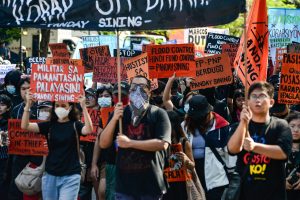Massive protests were held on September 21 in Metro Manila and other major cities across the Philippines, denouncing large-scale corruption involving top officials in charge of the government’s infrastructure projects.
The two biggest protests in the capital region gathered more than 100,000 people demanding truth and accountability for systemic corruption in the bureaucracy. Supporters of former President Rodrigo Duterte also organized two protest centers, including one in front of the military headquarters, but only a few people showed up. Another protest led by young people who seemed to be inspired by the uprisings in Indonesia and Nepal turned into a violent confrontation with the police near the Malacañang presidential palace. Outside Manila, various protests were also held in major urban centers reflecting the widespread outrage against the latest corruption scandal linked to the government’s flood-control program.
The common issue of the protests is the strong condemnation of corruption after it was exposed that numerous infrastructure projects have turned out to be nonexistent, while officials who nominated the projects and endorsed the bid of their favored contractors allegedly received kickbacks amounting to billions of pesos.
President Ferdinand Marcos Jr. has expressed surprise over the extent of corruption, and he vowed to pursue accountability after establishing an independent commission to investigate and submit recommendations on anomalous infrastructure projects. He even claimed that he would be in the streets protesting against corruption if he were not the president.
The president is spearheading the anti-corruption campaign, even if his motive is in question. Critics point out that Marcos is feigning surprise about the corruption-tainted projects despite signing the budget law containing pork barrel entitlements and dubious congressional insertions. He directed public attention towards the controversial projects of some legislators, which raised suspicion that he is being selective in his anti-corruption drive. He has remained mum about his utilization of confidential funds while his allies in Congress prevented opposition lawmakers from scrutinizing the budget of the office of the president.
Some protesters are cautious in calling for the resignation of Marcos since this would make Vice President Sara Duterte the country’s new leader. She is not only embroiled in a corruption scandal but the prospect of her family’s return to power has alarmed those who have suffered persecution during the previous Rodrigo Duterte administration.
But it is still ironic for Marcos to express solidarity with the September 21 anti-corruption protests, given the date’s historical significance. Every year, Filipinos commemorate the Martial Law declaration on September 21, 1972, which gave absolute power to Marcos’ father, Ferdinand Marcos Sr. Authoritarian rule enabled the Marcoses and their cronies to plunder the country’s resources. The Marcoses fled the country during the People Power revolt in 1986, but they largely retained their ill-gotten wealth. This year’s commemoration of Martial Law was meant to remind the public about the continuing impunity and notorious legacy of corruption in Filipino society.
Ahead of the protests, the popular indignation against corrupt legislators was the decisive factor in the change of leadership in the Senate and House of Representatives. It also led to the removal of key officials in charge of the government’s infrastructure projects. More importantly, it highlighted the role of public vigilance and engagement in holding officials to account regarding how they use government funds.
The protests on September 21 succeeded in gathering the largest anti-corruption crowd since 2013, when the “Million People March” forced the government to abolish the pork barrel system. The nationwide protests this year affirmed the outcry against corruption and the clamor for accountability. The violence that erupted between young protesters and the police gave face to the deep anger, despair, and desperation among the ranks of the poor. Authorities are now depicting the youth protesters as crazed misfits who only meant to sow violence and destruction. What they fail to see is the rising discontent among the youth who feel neglected by a system that favors and protects the rich and powerful.
The flood control corruption controversy implicated politicians belonging to the ruling coalition under the present and previous administrations, and triggered the massive protests on September 21. Marcos welcomed the protests as a way for the people to vent their frustration, but the fury unleashed by the youth near the presidential palace sparked a raging debate about the meaning of resistance, social change, rule of law, peace and order, structural violence, and the power of the oppressed.
Anti-corruption protests are expected to continue amid the ongoing investigations in Congress and by the independent commission created by the president. Failure to punish high-ranking corrupt officials and the refusal to eliminate all forms of pork barrel could lead to another huge anti-corruption protest. The president thinks he can control the narrative and the direction of the anti-corruption movement. The September 21 protest, especially the emergence of young protesters who do not belong to any mainstream organized formation, provided a vivid demonstration of how the seemingly predictable anti-corruption campaign initiated by no less than the president himself could turn into another political force with a potentially disruptive impact on society.





























